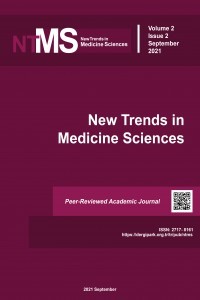Comparison of Chloral Hydrate and Hydroxyzine in Pediatric Electroencephalogram Recording; Sedation Successes and Changes in Vital Signs
Comparison of Chloral Hydrate and Hydroxyzine in Pediatric Electroencephalogram Recording; Sedation Successes and Changes in Vital Signs
Child, Chloral hydrate Electroencephalogram, Hydroxyzine, Sedation,
___
- 1. Angus-Leppan H. Seizures and adverse events during routine scalp electroencephalography: A clinical and EEG analysis of 1000 records. Clin Neurophysiol 2007; 118: 22-30.
- 2. Liamsuwan S, Grattan-Smith P, Fagan E, et al. The value of partial sleep deprivation as routine measure in pediatric electroencephalography. Journal of Child Neurology 2000; 15: 26-29.
- 3. Sezer T, Alehan F. Chloral hydrate versus hydroxyzine HCL for sedation prior to pediatric sleep EEG recording. Int J Neurosci 2013; 123: 719-723.
- 4. Olson DM, Sheehan MG, Thompson W, et al. Sedation of children for electroencephalograms. Pediatrics 2001; 108: 163-165.
- 5. Fallah R, Alaei A, Akhavan Karbasi S, et al. Chloral hydrate, chloral hydrate-promethazine and chloral hydrate-hydroxyzine efficacy in electroencephalography sedation. Indian J Pediatr 2014; 81: 541-546.
- 6. Dirani M, Nasreddine W, Melhem J, et al. Efficacy of the Sequential Administration of Melatonin, Hydroxyzine, and Chloral Hydrate for Recording Sleep EEGs in Children. Clin EEG Neurosci 2017; 48: 41¬¬-47. 7. Bektas O, Arıca B, Teber S, et al. Chloral hydrate and/or hydroxyzine for sedation in pediatric EEG recording Received. Brain Dev 2014; 36: 130-136.
- 8. Faytrouny M, Okte Z, Kucukyavuz Z. Comparison of two different dosages of hydroxyzine for sedation in the paediatric dental patient. Int J Paediatr Dent 2007; 17: 378-382.
- 9. Coté CJ, Wilson S. Work Group on Sedation. Guidelines for Monitoring and Management of Pediatric Patients During and After Sedation for Diagnostic and Therapeutic Procedures: An Update. Pediatrics 2006; 118: 2587-2602.
- 10. American Society of Anesthesiologists. Practice Guidelines for Sedation and Analgesia by Non-Anesthesiologists. Anesthesiology 2002; 96: 1004-1017.
- 11. Bailey PL, Pace NL, Ashburn MA, et al. Frequent hypoxemia and apnea after sedation with Midazolam and Fentanyl. Anesthesiology 1990; 73: 826-830.
- 12. Freeman R, Wieling W, Axelrod FB, et al. Consensus statement on the definition of orthostatic hypotension, neurally mediated syncope and the postural tachycardia syndrome. Clinical Autonomic Research 2011; 21: 69-72.
- 13. Dublin A. Distrubances of Rate and Rhythm of the Heart. In: Kliegman RM, Behrman RE, Jenson HB, Stanton BF, editors. Nelson Textbook of Pedıatrics, Philadelphia: Saunders Elsevier; 2007, p.1942-1950.
- 14. Bernstein D. Evaluation of the Cardiovascular System. In: Kliegman RM, Behrman RE, Jenson HB, Stanton BF, editors. Nelson textbook of pedıatrıcs, Philadelphia: Saunders Elsevier; 2007, p.1857-1864.
- 15. Ramsay MA, Savege TM, Simpson BR, et al. Controlled sedation with alphaxalone-alphadolone. Br Med J 1974; 22: 656-659.
- 16. Ronchera-Oms CL, Casillas C, Marti-Bonmati L. Oral chloral hydrate provides effective and safe sedation in paediatric magnetic resonance imaging. J Clin Pharm Ther 1994; 19: 239-243.
- 17. Heistein LC, Ramaciotti C, Scott WA, et al. Chloral hydrate sedation for pediatric echocardiography:physiologic responses, adverse events, and risk factors. Pediatrics 2006; 117: 434-444.
- 18. Ashrafi MR, Azizi Malamiri R, Zamani GR, et al. Sleep Inducing for EEG Recording in Children: A Comparison between Oral Midazolam and Chloral Hydrate. Iran J Child Neurol 2013; 7: 15-19.
- 19. De Jonghe B, Cook D, Appere-De-Vecchi C, et al. Using and understanding sedation scoring systems: a systematic review. Intensive Care Med 2000; 26: 275-285.
- 20. Motas D, McDermott NB, VanSickle T, et al. Depth of consciousness and deep sedation attained in children as administered by nonanaesthesiologists in a children’s hospital. Paediatr Anaesth 2004; 14: 256-260.
- 21. Malviya S, Voepel-Lewis T, Tait AR, et al. Depth of sedation in children undergoing computed tomography: validity and reliability of the University of Michigan Sedation Scale (UMSS). Br J Anaesth 2002; 88: 241-245. 22. Coté, C. J, Wilson, S. Guidelines for monitoring and management of pediatric patients before, during, and after sedation for diagnostic and therapeutic procedures: update 2016. Pediatric dentistry 2016; 38, 13E-39E.
- 23. Vade A, Sukhani R, Dolenga M, et al. Chloral hydrate sedation of children undergoing CT and MR imaging: safety as judged by American Academy of Pediatrics guidelines. AJR Am J Roentgenol 1995; 165: 905-909.
- 24. Greenberg SB, Faerber EN, Aspinall CL, et al. High-dose chloral hydrate sedation for children undergoing MR imaging: safety and efficacyin relation to age. AJR Am J Roentgenol 1993; 16: 639-641.
- 25. Soergel M, Kirschstein M, Busch C, et al. Oscillometric twentyfour-hour ambulatory blood pressure values in healthy children and adolescents: a multicenter trial including 1141 subjects. J Pediatr 1997; 130: 178-184.
- 26. Chen Z, Lin M, Huang Z, et al. Efficacy of chloral hydrate oral solution for sedation in pediatrics: a systematic review and meta-analysis. Drug Des Devel Ther 2019; 3: 2643-2653.
- 27. Fong CY, Tay CG, Ong LC, et al. Chloral hydrate as a sedating agent for neurodiagnostic procedures in children. Cochrane Database Syst Rev. 2017 Nov 3; 11(11): CD011786. doi: 10.1002/14651858.CD011786.pub2. PMID: 29099542; PMCID: PMC6486182.
- ISSN: 2717-8161
- Başlangıç: 2020
- Yayıncı: Fazile Nur Ekinci Akdemir
Evaluation of Main Inflammatory Markers on Peripheral Vertigo Attack
Hospital Infection Rates and Resistance Profiles in the Neonatal Intensive Care Unit
Low Serum Myeloperoxidase Levels in Multiple Sclerosis Patients
Nuray BİLGE, Recep YEVGİ, Nazım KIZILDAĞ, Ahmet KIZILTUNÇ
Blunt Abdominal Trauma Analysis in the Deaths due to Traffic Accidents in Erzurum, Turkey
Mustafa Talip ŞENER, Talip VURAL, Yiğit SEZER, Ahmet Nezih KÖK
Terman GÜMÜŞ, Cem YÜCEL, Suna OKTAR, Hakan ÖZDEMİR, Baran ÖNAL, Erhan Turgut ILGIT
Muhammed Enes AYDIN, Şaban Cem SEZEN, Mustafa ARSLAN, Meral ERDAL, Mustafa KAVUTCU
Çiğdem Eda BALKAN BOZLAK, Özgür ÇELEBİ
Thymoquinone Ameliorates Indomethacin-Induced Gastric Ulcers in Rats: A Dose Response Study
Yasin BAYIR, Cemile TURAN, Yalçın KARAGÖZ, Abdulmecit ALBAYRAK, Beyzagül ERKAYMAN, Lale DUYSAK
Clinicopathological Characteristics of Endometrial Carcinosarcomas: A Single-Center Experience
